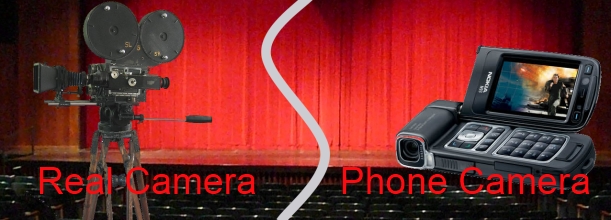The Auteur Is Dead, Long Live The…

“We once believed we were auteurs but we weren’t. We had no idea, really. Film is over. It’s sad nobody is really exploring it. But what to do? And anyway, with mobile phones and everything, everyone is now an auteur.”
These were the comments of a recent interview given by Jean-Luc Godard to promote his latest offering, Film Socialisme. Now, Godard is one of those characters who is deliberately and often provocative, both in his work and his public persona, so it’s hard to know how to take this statement. Perhaps it was just a way to drum up publicity given the comparatively small release given to his film, or perhaps he truly is lamenting what he sees as the demise of cinema.

The “we” to which Godard refers is the Nouvelle Vague, a group of young, ambitious cinephile-directors which included Francois Truffaut, Alan Resnais and Agnes Varda. The Nouvelle Vague believed in the auteur theory that lauded the director as the sole creative vision behind a film, and introduced the concept of the “camera-stylo”, or ‘camera pen’, to the cinematic vocabulary. For the first time this group of directors brought film out of the studios and into the streets, the influence of which can be directly seen in the New Hollywood films of the 1960s and 1970s, such as Butch Cassidy & The Sundance Kid or Bonnie & Clyde, which Godard was initially mooted to direct.
I spoke to Dr. Sarah Cooper, head of the Film Studies department at King’s College London and specialist in French Cinema, who claims Godard’s comment that film is over “could be understood to pertain to the rise of new technologies, particularly the digital, and the expanded possibilities that these create (e.g. ‘filming’ with mobile phones when ‘film’ in the most material sense, i.e. celluloid, is becoming rarer and rarer)”. This theory is given further credence with the recent news that rival film stock companies Technicolor and Deluxe have had to sign sub-contracting deals with each other to stay afloat. Also, despite the fact that the novelty is surely waning, the 3D boom shows no sign of stopping.

All this points to an increasing difficulty in getting films by first time directors made, or at least into the high street cinema chains, whereupon they’ll still face competition from some big budget identikit Hollywood blockbuster about nothing. However, Rebecca O’Brien, producer and long-time collaborator with veteran director Ken Loach, still has faith that “any good film will get made”. When quizzed on whether the increasing amount of illegal downloads and film piracy that’s going on is leading to an increased difficulty in money being put into less commercially viable films, she argued that the reason for internet piracy was that there is an economic flaw in the market, saying that “films are not available at the right time for the right price”.
The model she proposed was very convincing, and certainly not beyond the realm of possibility – a mode of exhibition whereby the film is released on a multi-platform basis, digitally and cinematically, with people given the option to either pay a higher price for the true cinematic experience, or else pay a lower price to download a lower quality movie. Could this be the way of the future for independent films?

Already there are film-makers who are making good use of the internet to help promote themselves and their work, for both independent films and big budget blockbusters. One need only look at the use of viral marketing to amp up the buzz for Super 8 to see how effective it can be when utilised properly. I spoke to Lee Neville, director and star of Time Stops Moving and the sequel Time Always Moving (a review of which you’ll be able to read next week) about his use of the internet. Neville, in an attempt to get noticed by studio production companies, makes and stars in no-budget short films for internet distribution.
“It’s essentially creating your own showreel.” He said, “And being that they are my films I get to give myself a leading role. Last year I presented four short films online and though they were zero budget and low tech, I don’t think this is why the views weren’t amazingly high. There was no way any of my short films would compete with the clip of the jumping cat… The exception to the case was a short film called Time Stops Moving which got the attention of a US casting director and had a few thousand views. Inspired by this I chose to create the sequel Time Always Moving.”

Neville also mentioned the festival circuit as being integral in showcasing what you have to offer, and thankfully this seems healthy enough to still have a great effect on the success of indie films. Take Treacle Jr., Jamie Thraves’ follow up to 2000’s critically acclaimed The Low-Down, and probably my favourite film to have come out this year. Shot on a micro budget, it is the kind of film that would inspire any would-be filmmaker to pick up a DSLR and go make a movie. The film acquired a minor distribution deal from the New British Cinema Quarterly after being shown at the London Film Festival, and then winning the Hitchcock D’or at the Dinard Film Festival (Notable previous winners include Shallow Grave, The Full Monty and Dead Man’s Shoes).
Thraves spent no money on advertising its limited, week long release in selected Picturehouses and still managed to attract around 300 viewers; all the more impressive considering it was competing against Bridesmaids, The Tree of Life and the latest in the Harry Potter franchise. It may not sound a lot, but word of mouth is a powerful thing, and hopefully this will mean that when Treacle Jr. comes back to London in August, playing at the Shortwave Cinema in Bermondsey Square, and then for a week at The Ritzy, its audience numbers will increase.

In fact, the tour Treacle Jr. is going on, again organised by the NBCQ, calls to mind a similar exhibition practice used recently by Kevin Smith. Instead of spending big bucks on pushing his latest film, Red State, Smith decided instead to distribute it and market it himself, taking it on a tour around the USA. By spending nothing on advertising, the film has already recouped its relatively small budget, and hopefully the same thing will happen with Treacle Jr. (Thraves did remortgage his house to fund the project!).
It’s this kind of creative, anarchic thinking being employed by Thraves, Smith, Neville and many others – the kind that made the French New Wave so influential – that needs to exist if independent cinema is to survive and flourish. See, people are exploring cinema, but more often than not they just exist slightly below the radar, biding their time, making low budget films and waiting for their audience find them; half the battle is getting people to realise that there are new films out there beyond what’s on in the West End. Cinema is in a transitional period at the moment, but once it is through then hopefully the landscape will be healthier for studios and independents alike.





Recent Comments